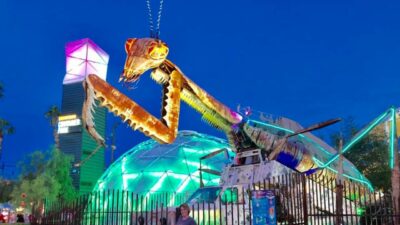Lori Ballen, the owner of this website, benefits from purchases made through her affiliate links.
Why was Hoover Dam Built?
Like Las Vegas itself, many might view Hoover Dam as a tourist trap. However, Hoover Dam is a marvel of American ingenuity and construction. The dam was constructed in the 1930s as part of President Franklin D. Roosevelt’s massive works programs to provide jobs during the depth of the Great Depression.
People also ask: What other Quick Getaways from Las Vegas Are There?
Are there Tours at Hoover Dam?
Two tours are available each day. One tour takes visitors inside the structure to see the power plant operated at the dam. The other tour is more extensive and takes guests on a guided tour through the passageways in the depths of the structure. The latter tour, it should be noted, includes a significant amount of walking.
Bonus destination nearby: Boulder City, Nevada. Boulder City lies along the banks of Lake Mead, which was created by the damming of the Colorado River and is the largest water reservoir in the United States (by volume). Boulder City was built to house the workers and their families during the dam’s construction.
What is the Purpose of Hoover Dam Today?
Today, the Dam still serves the purpose of blocking up the Colorado River to supply power to public and private utilities in Nevada and the neighboring states of Arizona and California. Daily charter buses run between Las Vegas and the Hoover Dam, meaning you won’t even need to drive yourself. Once there, you cannot pass on the chance to go inside the structure itself.
Where is Hoover Dam?
Hoover Dam is at the Lake Mead National Recreation Area in the Zip Code 89005 in Nevada. It takes about 45 minutes to get to Hoover Dam from Summerlin, and about 30 minutes from downtown Las Vegas.
About Hoover Dam
Hoover Dam is a concrete arch-gravity dam in the Black Canyon of the Colorado River, on the border between the U.S. states of Arizona and Nevada. It was constructed between 1931 and 1936 during the Great Depression and was dedicated on September 30, 1935, by President Franklin D. Roosevelt. Its construction was the result of a massive effort involving thousands of workers and cost over one hundred lives. The dam was named after President Herbert Hoover.
The Black Canyon and nearby Boulder Canyon were among the darkest areas of the United States inaccessible to public viewing until approximately 1893 with the installation of electric lighting in Las Vegas, Nevada (then a small settlement) some away. In 1928, Congress authorized the Hoover Dam project (originally named “Boulder Canyon Project”) and provided funding for it.
The eventual design called for a dam high and across. The Black Canyon was a particularly difficult area to devise a safe reservoir location of this magnitude; geologic studies were required because of uncertainty about precise geological formations in the canyon. The final design was a concrete arch-gravity dam, the crest of which passes in air above the river.
Boulder City (originally “Gould”) and other communities were constructed in the canyon downstream of the future dam site. The ruins of buildings erected in Boulder City during its heyday can still be seen at the end of Nevada State Route 294.
Some of the engineers on this project were J.L. Warner and W.H. Wattis, who left Boulder City in 1942 after overseeing the completion of one high section of the dam. They never returned to it.[clarification needed] The two men faced a fine if they disclosed proprietary information about “the dam’s structural design and workings”. Such a disclosure would have invalidated the Hoover Dam patents.
The concrete for the dam was produced at the Bureau of Reclamation’s Little Mountain plant, in nearby Nevada (now owned by Vic Braden). The dam was dedicated on September 30, 1935, by President Franklin D. Roosevelt. Immediately downstream from the dam site, the river forms the Black Canyon, a steep-sided gorge within which the Hoover Dam Bridge was constructed.
Today, Hoover Dam produces more than 4 billion kilowatt-hours of electricity annually (as of 2007) and provides for approximately 1% of annual in-state-generated power demand in Nevada.[28] In addition, the dam provides water for the irrigation of as much as 340,000 acres (1,400 km2) within Nevada and Arizona. Hoover Dam is operated by the Bureau of Reclamation on behalf of the Federal Government’s Department of Interior and aims to help meet America’s growing energy and water needs.





